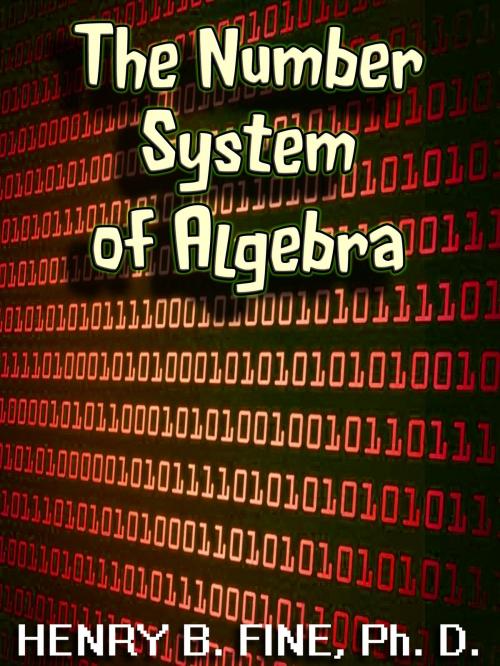The Number System of Algebra: Number Systems from the Egyptians to the Greeks to the Europeans to Arabic
Nonfiction, Science & Nature, Mathematics, Algebra, Calculus, Science, Physics, General Physics| Author: | Henry B. Fine, Ph.D. | ISBN: | 1230000144089 |
| Publisher: | Fine | Publication: | June 22, 2013 |
| Imprint: | Language: | English |
| Author: | Henry B. Fine, Ph.D. |
| ISBN: | 1230000144089 |
| Publisher: | Fine |
| Publication: | June 22, 2013 |
| Imprint: | |
| Language: | English |
I THEORETICAL
1 THE POSITIVE INTEGER,
AND THE LAWS WHICH REGULATE THE ADDITION AND
MULTIPLICATION OF POSITIVE INTEGERS
The number concept
Numerical equality
Numeral symbols
The numerical equation
Counting
Addition and its laws
Multiplication and its laws
2 SUBTRACTION AND THE NEGATIVE INTEGER
Numerical subtraction
Determinateness of numerical subtraction
Formal rules of subtraction
Limitations of numerical subtraction
Symbolic equations
Principle of permanence. Symbolic subtraction
Zero
The negative
Recapitulation of the argument of the chapter
3 DIVISION AND THE FRACTION
Numerical division
Determinateness of numerical division
Formal rules of division
Limitations of numerical division
Symbolic division. The fraction
Negative fractions
General test of the equality or inequality of fractions
Indeterminateness of division by zero
Determinateness of symbolic division
The vanishing of a product
The system of rational numbers
4 THE IRRATIONAL
Inadequateness of the system of rational numbers
Numbers defined by regular sequences. The irrational
Generalized definitions of zero, positive, negative
Of the four fundamental operations
Of equality and greater and lesser inequality
The number defined by a regular sequence its limiting value
Division by zero
The number-system defined by regular sequences of rationals a closed and continuous system
5 THE IMAGINARY COMPLEX NUMBERS
The pure imaginary
Complex numbers
The fundamental operations on complex numbers
Numerical comparison of complex numbers
Adequateness of the system of complex number
Fundamental characteristics of the algebra of number
6 GRAPHICAL REPRESENTATION OF NUMBERS THE VARIABLE.
Correspondence between the real number-system and the points of a line
The continuous variable
Correspondence between the complex number-system and the points of a plane
The complex variable
Definitions of modulus and argument of a complex number and of sine,
cosine, and circular measure of an angle
Construction of the points which represent the sum, difference, product,
and quotient of two complex numbers
7 THE FUNDAMENTAL THEOREM OF ALGEBRA
Definitions of the algebraic equation and its roots
Demonstration that an algebraic equation of the nth degree has n roots
8 INFINITE SERIES
8.1 REAL SERIES
Definitions of sum, convergence, and divergence
General test of convergence
Absolute and conditional convergence
Special tests of convergence
Limits of convergence
The fundamental operations on infinite series
8.2 COMPLEX SERIES
General test of convergence
Absolute and conditional convergence
The region of convergence
A theorem respecting complex series
The fundamental operations on complex series
9 THE EXPONENTIAL AND LOGARITHMIC FUNCTIONS UNDETERMINED COEFFICIENTS. INVOLUTION AND EVOLUTION. THE BINOMIAL THEOREM
Definition of function
Functional equation of the exponential function
Undetermined coefficients
The exponential function
The functions sine and cosine
Periodicity of these functions
The logarithmic function
Indeterminateness of logarithms
Permanence of the laws of exponents
Permanence of the laws of logarithms
Involution and evolution
The binomial theorem for complex exponents
II HISTORICAL
10 PRIMITIVE NUMERALS
Gesture symbols
Spoken symbols
Written symbols
11 HISTORIC SYSTEMS OF NOTATION
Egyptian and Phoenician
Greek
Roman
Indo-Arabic
12 THE FRACTION
Primitive fractions
Roman fractions
Egyptian (the Book of Ahmes)
Babylonian or sexagesimal
Greek
13 ORIGIN OF THE IRRATIONAL
Discovery of irrational lines. Pythagoras
Consequences of this discovery in Greek mathematics
Greek approximate values of irrationals
14 ORIGIN OF THE NEGATIVE AND THE IMAGINARY.
15 ACCEPTANCE OF THE NEGATIVE
16 RECOGNITION OF THE PURELY SYMBOLIC CHARACTERS OF ALGEBRA
I THEORETICAL
1 THE POSITIVE INTEGER,
AND THE LAWS WHICH REGULATE THE ADDITION AND
MULTIPLICATION OF POSITIVE INTEGERS
The number concept
Numerical equality
Numeral symbols
The numerical equation
Counting
Addition and its laws
Multiplication and its laws
2 SUBTRACTION AND THE NEGATIVE INTEGER
Numerical subtraction
Determinateness of numerical subtraction
Formal rules of subtraction
Limitations of numerical subtraction
Symbolic equations
Principle of permanence. Symbolic subtraction
Zero
The negative
Recapitulation of the argument of the chapter
3 DIVISION AND THE FRACTION
Numerical division
Determinateness of numerical division
Formal rules of division
Limitations of numerical division
Symbolic division. The fraction
Negative fractions
General test of the equality or inequality of fractions
Indeterminateness of division by zero
Determinateness of symbolic division
The vanishing of a product
The system of rational numbers
4 THE IRRATIONAL
Inadequateness of the system of rational numbers
Numbers defined by regular sequences. The irrational
Generalized definitions of zero, positive, negative
Of the four fundamental operations
Of equality and greater and lesser inequality
The number defined by a regular sequence its limiting value
Division by zero
The number-system defined by regular sequences of rationals a closed and continuous system
5 THE IMAGINARY COMPLEX NUMBERS
The pure imaginary
Complex numbers
The fundamental operations on complex numbers
Numerical comparison of complex numbers
Adequateness of the system of complex number
Fundamental characteristics of the algebra of number
6 GRAPHICAL REPRESENTATION OF NUMBERS THE VARIABLE.
Correspondence between the real number-system and the points of a line
The continuous variable
Correspondence between the complex number-system and the points of a plane
The complex variable
Definitions of modulus and argument of a complex number and of sine,
cosine, and circular measure of an angle
Construction of the points which represent the sum, difference, product,
and quotient of two complex numbers
7 THE FUNDAMENTAL THEOREM OF ALGEBRA
Definitions of the algebraic equation and its roots
Demonstration that an algebraic equation of the nth degree has n roots
8 INFINITE SERIES
8.1 REAL SERIES
Definitions of sum, convergence, and divergence
General test of convergence
Absolute and conditional convergence
Special tests of convergence
Limits of convergence
The fundamental operations on infinite series
8.2 COMPLEX SERIES
General test of convergence
Absolute and conditional convergence
The region of convergence
A theorem respecting complex series
The fundamental operations on complex series
9 THE EXPONENTIAL AND LOGARITHMIC FUNCTIONS UNDETERMINED COEFFICIENTS. INVOLUTION AND EVOLUTION. THE BINOMIAL THEOREM
Definition of function
Functional equation of the exponential function
Undetermined coefficients
The exponential function
The functions sine and cosine
Periodicity of these functions
The logarithmic function
Indeterminateness of logarithms
Permanence of the laws of exponents
Permanence of the laws of logarithms
Involution and evolution
The binomial theorem for complex exponents
II HISTORICAL
10 PRIMITIVE NUMERALS
Gesture symbols
Spoken symbols
Written symbols
11 HISTORIC SYSTEMS OF NOTATION
Egyptian and Phoenician
Greek
Roman
Indo-Arabic
12 THE FRACTION
Primitive fractions
Roman fractions
Egyptian (the Book of Ahmes)
Babylonian or sexagesimal
Greek
13 ORIGIN OF THE IRRATIONAL
Discovery of irrational lines. Pythagoras
Consequences of this discovery in Greek mathematics
Greek approximate values of irrationals
14 ORIGIN OF THE NEGATIVE AND THE IMAGINARY.
15 ACCEPTANCE OF THE NEGATIVE
16 RECOGNITION OF THE PURELY SYMBOLIC CHARACTERS OF ALGEBRA















